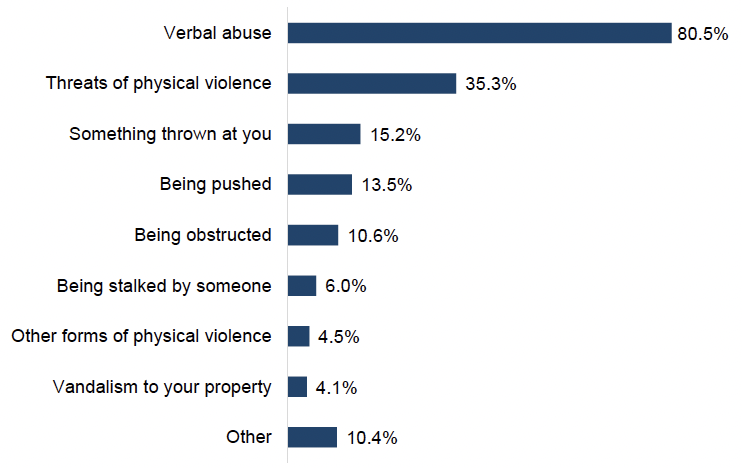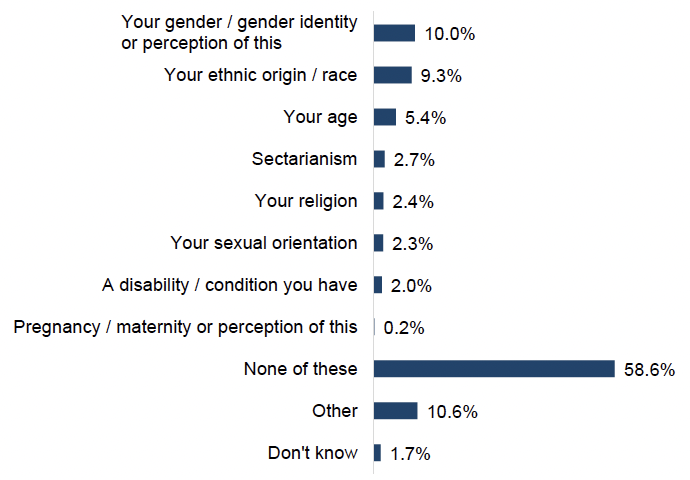Scottish Crime and Justice Survey 2021/22: Main Findings
Main findings from the Scottish Crime and Justice Survey 2021/22.
9.2. Focus on harassment and discrimination
This section reports on adults’ experiences of harassment and discrimination, by examining whether they had any incidents in which they were insulted, pestered or intimidated in any way (in person or by some other means[124]) by someone outwith their household in the year prior to interview.
These findings are based on questions asked to one-quarter of the overall sample[125]. As agreed with SCJS users, quarter-sample results are generally not broken down within the report for population sub-groups. However, some breakdowns are presented here for illustration. All results for demographic and area characteristics are provided in the 2021/22 SCJS online data tables.
Additional information on other experiences of stalking and harassment are captured in the self-completion element of the SCJS with the below summary focusing on key findings on this topic from the main (face-to-face) survey. Key findings on each of the self-completion topics from SCJS interviews conducted in 2018/19 and 2019/20 (described where relevant as 2019/20) can be found in the 2019/20 Main Findings Report. Due to improvements made to the partner abuse questionnaire for the 2023/24 survey sweep, analysts are currently developing plans on how to publish the findings for the standalone 2021/22 year. Further background to these changes are detailed in Annex D: Changes to the survey for 2023/24, and users will be informed of future plans through the ScotStat network.
How common were experiences of harassment in Scotland in 2021/22?
In 2021/22, 14% of adults said that they had been insulted, pestered or intimidated in the previous year, in line with the proportion of respondents who experienced such incidents in 2008/09 and 2018/19.
Across two of the population sub-groups focused on in this report, sex and SIMD, there was no differences in the proportion that said they had been insulted, pestered or intimidated in the previous year. However the proportion was higher among victims than non-victims (25% compared to 12%, respectively), higher among urban dwellers than those living rurally (15% compared to 7% respectively), and, higher amongst those aged 16-24 when compared with those aged 60+ (24% compared to 7% respectively).
What can the SCJS tell us about the nature of harassment?
Of those who said they had experienced harassment in the year prior to interview the vast majority (80%) were insulted, pestered or intimidated ‘in person’, whilst 21% said this happened ‘in writing via text, email, messenger or posts on social media’. This suggests that ‘offline’ experiences of harassment remain much more common than ‘online’. However electronic communication does play a role in a sizeable proportion of cases of harassment. Further details on the insights the 2021/22 SCJS is able to shed on the relationship between the internet and crime are outlined in the ‘Cyber crime in Scotland’ section.
Most people who had experienced harassment said it had happened on more than one occasion in the previous year (68%), with 27% reporting only one incident. A further tenth (9%) of people said they experienced harassing behaviour too many times to remember.
Verbal abuse was the most common type of harassment in 2021/22, experienced by 80% of the victims. Other types of harassment, particularly those involving physical contact, were much less commonly experienced, as shown in Figure 9.5. More in-depth analysis about the extent and nature of violent incidents in 2021/22 is provided in the ‘Focus on violent crime’ chapter.
Figure 9.5: The majority of victims of harassment experienced verbal abuse with over a third experiencing threats of physical violence.

Base: All respondents who had been insulted, pestered or intimidated in previous 12 months (170). Variable: QHWHAT2.
To explore whether incidents may have been related to discrimination, respondents who experienced harassment in the previous 12 months were asked whether they thought any particular - perceived or actual - characteristic they hold may have motivated the offender in any encounters. A range of possible reasons in relation to the most recent (or only) experience are outlined in Figure 9.6 below.
Around three-in-five (59%) did not think any of their characteristics were an influencing factor in their most recent (or only) experience of harassment. One in ten (10%) thought that their gender, gender identity or perception of this was a possible motivating factor, while 5% believed their age and 9% believed their ethnic origin or race was a possible influence.
Since the last SCJS in 2019/20, there has been no change across all possible motivating factors.
Figure 9.6: The majority of victims did not think any of their characteristics were an influencing factor in their most recent harassment experience.

Base: All respondents who had been insulted, pestered or intimidated in previous 12 months (170). Variable: QHDISCRIM1.
Contact
Email: scjs@gov.scot
There is a problem
Thanks for your feedback